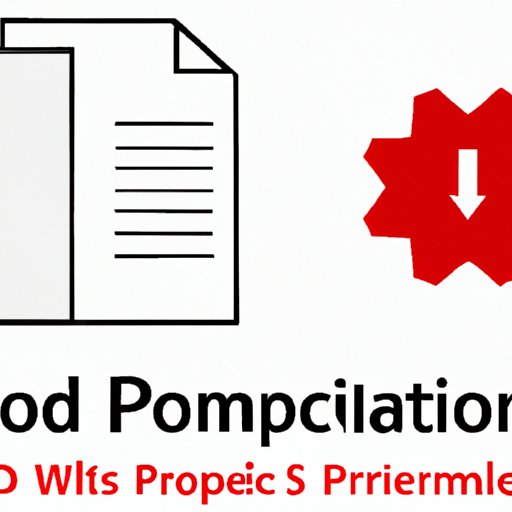I. Introduction
PDF (Portable Document Format) files have become a popular format because they maintain their formatting and can be easily viewed and shared. However, sometimes it may be necessary to convert a PDF to a Word document. In this article, we will explore the various tools and techniques available to convert PDFs to Word documents and discuss the pros and cons of this conversion.
II. A Comprehensive Guide to Converting PDFs to Word Documents
Converting a PDF to a Word document can be done using various tools, including online converters, software applications, and manual methods:
Using Online Converters: Online converters like Smallpdf, Adobe, and Zamzar are free tools that allow you to easily convert PDF files to Word documents. Simply upload your PDF file, select the Word format, and click convert.
Using Software Applications: Adobe Acrobat Pro, Nitro Pro, and other paid software applications are another way to convert PDF files to Word documents. These software tools provide more advanced features and allow you to edit your document before or after the conversion.
Manual Methods: Although less common, manually copying and pasting text from a PDF to a Word document or saving the PDF as a text file and importing it into Word are other ways to transfer the content from PDF to Word.
While the conversion process is relatively straightforward, there are some potential challenges to be aware of. For example, some PDFs may have certain elements, such as images or text boxes, that do not convert properly. Additionally, the formatting and layout of the document may get lost during the conversion.
III. The Pros and Cons of Converting PDFs to Word Documents
Converting a PDF to a Word document may offer some advantages and disadvantages:
Advantages: Converting a PDF to a Word document can make it easier to edit and customize the content. Additionally, a Word document can be more versatile, allowing users to share the document and adjust the formatting, fonts, and layout.
Disadvantages: There can be formatting issues, such as font inconsistencies or loss of images or text when converting a PDF to a Word document. Additionally, some PDFs are protected, and if you do not have access to the password, you cannot convert them to Word documents.
Depending on the situation, one option may be preferred over the other. For example, when filling out forms or creating templates, PDFs may be the better option as they maintain their formatting. In contrast, when collaborating or making revisions, a Word document may be more useful.
IV. The Best Tools to Convert PDFs to Word Documents
The following tools provide the most comprehensive and efficient ways to convert PDF to Word:
1. Adobe Acrobat Pro DC: This software is available for both Mac and Windows and can convert multiple files at once with high accuracy. Additionally, it offers features like OCR (Optical Character Recognition) and batch conversion.
2. Smallpdf: This online converter offers both free and paid services. The free service is straightforward, and the paid service includes features like batch processing, password protection, and the ability to edit the document before converting.
3. Nitro Pro: This software is an alternative to Adobe Acrobat and offers similar features like OCR, batch conversion, and document merging.

V. Common Problems and Solutions When Converting PDFs to Word Documents
There are a few common problems that people face when converting PDFs to Word documents, such as:
1. Formatting Issues: Sometimes, the font, layout, and images in the original document may not be transferred properly to the Word document. To avoid this, make sure to use a reliable conversion tool and preview the document after the conversion.
2. Scanned PDFs: If the PDF is a scanned document, the text cannot be edited, and OCR software must be used to convert it to editable text before converting it to a Word document.
3. Password Protection: If the PDF is password-protected and you do not have access to the password, conversion software cannot convert it to a Word document.
VI. Convert PDFs to Word Documents Without Losing Formatting
To preserve the formatting of a PDF when converting it to a Word document, consider using the following techniques:
1. Use a reliable conversion tool: Select a premium online or offline PDF to a Word converter that retains formatting and offers customization options.
2. Preview the document: After conversion, preview the document to check for formatting inconsistencies and troubleshoot them immediately.
3. Prioritize readability: Select the font, styles, and layout that offer the best readability while maintaining the formatting.
VII. Why There is a Need to Convert PDFs to Word Documents
The need to convert PDFs to Word documents may arise in various situations:
1. Creating reusable templates: PDFs are commonly used to create templates, but converting them to Word documents allows for further customization, editing, and sharing.
2. Collaboration and editing: Collaborating on a Word document is generally easier than on a PDF document. By converting a PDF to a Word document, users can work on the document together or edit documents to create different versions.
3. Archiving and sharing: Archiving and sharing documents is simpler in Word format as it is compatible with more devices and applications than PDFs.
VIII. Conclusion
In conclusion, converting PDFs to Word documents is a common task that people encounter, and there are several tools and methods available. While there may be formatting issues, conversion software and manual techniques can preserve the majority of the content and format. It’s essential to evaluate the advantages and disadvantages of each format and choose an appropriate one based on the situation. We hope this comprehensive guide has provided helpful insights and recommendations on converting PDFs to Word documents.
